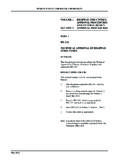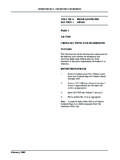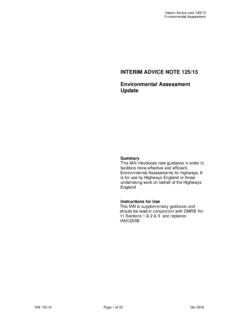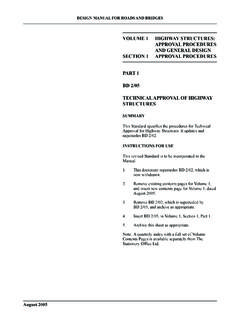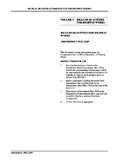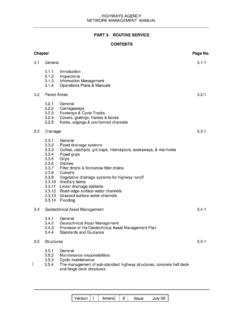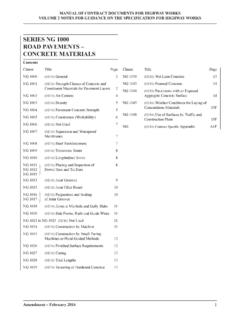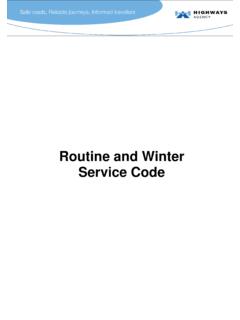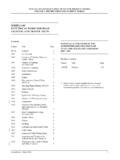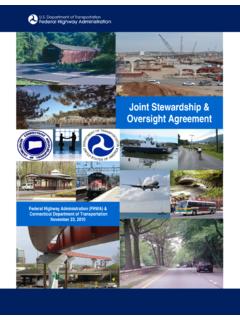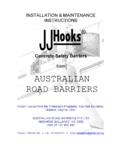Transcription of DMRB VOLUME 7 SECTION 2 PART 1 - HD 24/06 - TRAFFIC …
1 February 2006 design MANUAL FOR ROADS AND BRIDGESVOLUME 7 pavement design ANDMAINTENANCESECTION 2 pavement design ANDCONSTRUCTIONPART 1HD 24/06 TRAFFIC ASSESSMENTSUMMARYThis Standard sets out the method for the estimationand calculation of TRAFFIC loading for the design of roadpavements. design aids are provided for easydetermination of the number of standard axles for use inthe pavement design standard HD 26 (DMRB ). Itsupersedes HD 24 FOR Contents pages from VOLUME 7 andinsert new Contents pages for VOLUME 7 datedFebruary HD 24/96 from VOLUME 7, SECTION 2which is superseded by this Standard and archiveas HD 24/06 into VOLUME 7, SECTION archive this sheet as : A quarterly index with a full set of VolumeContents Pages is available separately from TheStationery Office WITHIN design MANUAL FOR ROADS AND BRIDGESNOVEMBER 2006 SUMMARY OF CORRECTION HD 24/06 VOLUME 7, SECTION 2, Part 1 TRAFFIC ASSESSMENTC orrections have been made to figures in Tables and and also to equations.
2 Paragraph has also apologise for the inconvenience AgencyNovember 2006 London: The Stationery OfficeHD 24/06 TRAFFIC AssessmentSummary:This Standard sets out the method for the estimation and calculation of trafficloading for the design of road pavements. design aids are provided for easydetermination of the number of standard axles for use in the pavement designstandard HD 26 (DMRB ). It supersedes HD 24 MANUAL FOR ROADS AND BRIDGESTHE HIGHWAYS AGENCYSCOTTISH EXECUTIVEWELSH ASSEMBLY GOVERNMENTLLYWODRAETH CYNULLIAD CYMRUTHE DEPARTMENT FOR REGIONAL DEVELOPMENTNORTHERN IRELANDV olume 7 SECTION 2 Part 1 HD 24/06 February 2006 REGISTRATION OF AMENDMENTSA mendPage NoSignature & Date ofAmendPage NoSignature & Date ofNoincorporation ofNoincorporation ofamendmentsamendmentsRegistration of AmendmentsVolume 7 SECTION 2 Part 1 HD 24/06 February 2006 REGISTRATION OF AMENDMENTSA mendPage NoSignature & Date ofAmendPage NoSignature & Date ofNoincorporation ofNoincorporation ofamendmentsamendmentsRegistration of AmendmentsVOLUME 7 pavement design ANDMAINTENANCESECTION 2 pavement design ANDCONSTRUCTIONPART 1HD 24/06 TRAFFIC of design
3 And MANUAL FOR ROADS AND BRIDGESF ebruary 2006 VOLUME 7 SECTION 2 Part 1 HD 24/06 February 20061/1 Chapter 1 Introduction1. INTRODUCTIONM andatory of this document which form partof the Standards of the Overseeing Organisationsare highlighted by being contained in boxes. Theseare the sections with which the DesignOrganisations must comply, or must have agreed asuitable departure from Standard with the relevantOverseeing Organisation. The remainder of thedocument contains advice and enlargement whichis commended to design Organisations for Part covers the estimation of design trafficfor new roads, and the estimation of past and futuredesign TRAFFIC for the maintenance of existing the UK, road pavement structural wearresulting from TRAFFIC ( fatigue cracking within thebound pavement layers and/or excessive subgradedeformation) and pavement designs (for particularmaterials) are intrinsically related.
4 pavement designsfor flexible and rigid pavements are presented in HD 26(DMRB ). pavement structural wear in the UK isestimated using wear factors based on vehicle axleloads. Wear factors have been produced using actualloads measured with Weigh-in-motion (WIM) sensorsinstalled on the highway Part shall be used forthwith on all schemesfor the construction, improvement and maintenance oftrunk roads, including motorways, currently beingprepared provided that, in the opinion of the OverseeingOrganisation, this would not result in significantadditional expense or delay. design organisations mustconfirm its application to particular schemes with theOverseeing in Northern use in Northern Ireland, this Standardmust be applicable to those roads designated by theOverseeing 7 SECTION 2 Part 1 HD 24/062/1 Chapter 2 Calculation of design Traffic2.
5 CALCULATION OF design method shall be used to determine thepavement design TRAFFIC for new and existing it is considered inappropriate for any reason thenfurther advice must be sought from the design TRAFFIC is the commercial vehicleloading over the design period expressed as the numberof equivalent standard (80kN) axles; it is calculatedusing the commercial vehicle flow, TRAFFIC growth andwear method for calculating design trafficincorporates the latest research on wear and a trafficgrowth estimation based on the National Road TrafficForecast (NRTF, 1997). The background to the methodis reported in TRL Report PPR 066 (2006). factors used to calculate the design TRAFFIC (T) are as follows: Commercial Vehicle Flow at opening (F); design Period (Y); Growth Factor (G); Wear Factor (W); and Percentage of vehicles in the heaviest loaded lane(P).
6 If reliable data for all these factors are not available, achart giving an acceptable design value is described inParagraph Vehicle Flow (F) key element in the design is the flow ofcommercial vehicles. This is expressed as AnnualAverage Daily Flow (AADF) and is the flow measuredin one direction (1-way flow). If the TRAFFIC is measuredin both directions (2-way flow) this is converted intoAADF assuming a 50:50 directional split, unless trafficcounts or studies show a significant directional vehicles are defined as those tonnes gross vehicle weight. The structural wearcaused by lighter TRAFFIC ( bikes, cars and light goodsvehicles) is considered to be identifies the commercial vehicle (cv)classes and categories to be used, as defined in theCOBA manual (DMRB ).
7 New road schemes, the commercialvehicle class/category count data shall bedetermined from TRAFFIC studies using the principlesdescribed in the TRAFFIC Appraisal Manual(DMRB ). existing road schemes ( design or re-alignment), a classifiedcount shall be carried out over a 12, 16 or 24 hourperiod. This must be converted to an AADF usingthe principles given in the COBA manual(DMRB ). For Scotland, use NESA(DMRB ). To determine the design TRAFFIC , the AADFof commercial vehicles per day (cv/d) in onedirection, at scheme opening (or for existing roadschemes, the current flow) and the proportion inthe OGV2 category shall be 2006 VOLUME 7 SECTION 2 Part 1 HD 24/062/2 Chapter 2 Calculation of design TrafficTable Vehicle Classes andCategoriesCommercialcv class*cvvehicle (cv)categoryBuses andPSVC oaches2-axlerigidOGV13-axlerigid3-axlear ticulated4-axlerigid4-axlearticulatedOGV 25-axlearticulated6 (or more)
8 -axlearticulated* Classed by axles in contact with the roadPSV = Public Service VehicleOGV = Other Goods VehicleExampleCount data converted to AADF using COBA and Coaches32 PSV2 axle Rigid467 OGV13 axle Rigid 67 3 and 4 axle Articulated274 OGV24 axle Rigid 49 5 axle Articulated938 6 or more axle 530 _____Total Flow2,357cv/dTotal OGV2 Flow1,791cv/dPercentage OGV276% Typical average commercial vehicle flowcompositions are given in Table (Department forTransport, 2003). There is a wide variation in the valuesfor the proportion of commercial vehicles on the trunkroad network and the values in the table may beexceeded in many Commercial Vehicle FlowCompositionsRoad TypeMotorwayPrincipalor TrunkPercentage ofCommercial Vehicles114(% cv) within AADF% For new road designs, the percentage ofOGV2 vehicles shall be obtained by calculation ormodelling but shall not be less than the percentagegiven in Figure 2006 VOLUME 7 SECTION 2 Part 1 HD 24/062/3 Chapter 2 Calculation of design TrafficFigure Minimum Percentage of OGV2 Class Vehicles for New ConstructionDesign Period (Y) The number of years over which TRAFFIC is tobe assessed shall be selected.
9 For past TRAFFIC , thiswill generally be the number of years sinceopening or last major structural maintenance . Forfuture design TRAFFIC this shall generally be 40years. Other design periods may be used if provento be economic and agreed with the Whole life cost considerations are important tothe selection of the design period. A 40-year designperiod without structural maintenance has generallyproven to be the most economic, particularly wheretraffic flow is design TRAFFIC Calculation for For new carriageways, all lanes, includingthe hard shoulder, shall be designed to the samestandard as the heaviest loaded lane. The actualtraffic in other lanes is not Where additional information (seeParagraphs onwards) is not available, together with Figure shall be used tocalculate the design TRAFFIC for the total TRAFFIC flow( for all lanes in one direction) for a designperiod of 40-years.
10 In this case, the remainder ofChapter 2 can be Flow (cv/d)Minimum percentage of OGV2 vehicles (%)November 2006 VOLUME 7 SECTION 2 Part 1 HD 24/062/4 Chapter 2 Calculation of design TrafficGrowth Factor (G) The National Road TRAFFIC Forecast (NRTF)is published in eight year intervals and predictsfuture TRAFFIC trends. The 1997 NRTF growth linesshown for OGV1+PSV and for OGV2 (the boldlines on Figure ) shall be used unless specificalternative and more reliable local data Past growth, where known from TRAFFIC counts,can also be used to give an indication of future trends ina particular situation, but only where data over at least a10 year period are available, since averaging over ashorter period may give misleading For each cv class or category, TRAFFIC growthcan be calculated which is dependent on theselected design period and the growth rate.
